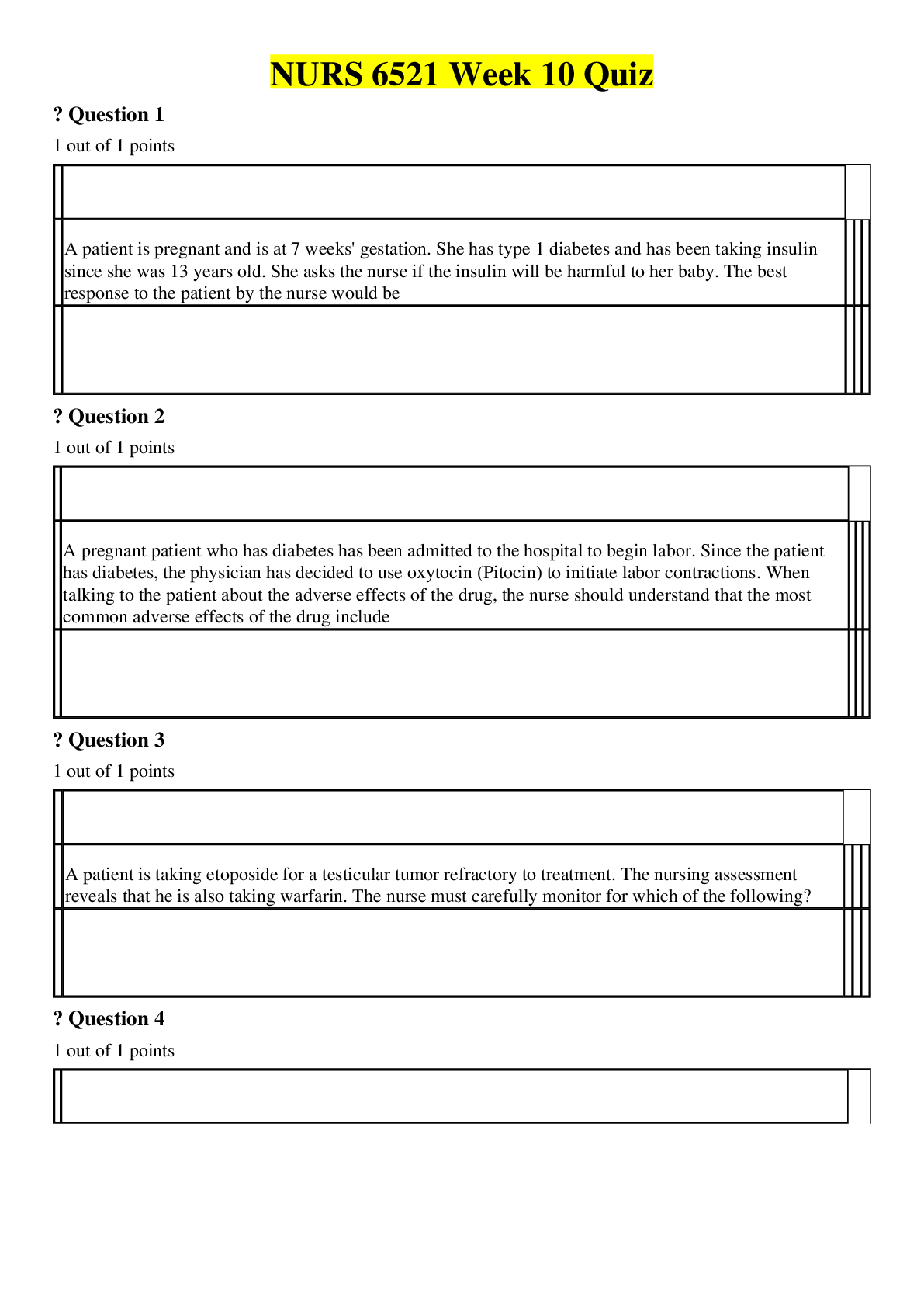NURS 6521 Week 10 Quiz.Q&A
Document Content and Description Below
NURS 6521 Week 10 Quiz.Q&A Question 1 1 out of 1 points A patient is pregnant and is at 7 weeks' gestation. She has type 1 diabetes and has been taking insulin since she was 13 years old. She ... asks the nurse if the insulin will be harmful to her baby. The best response to the patient by the nurse would be Response Feedback: The best response would be to tell the patient that insulin is the drug of choice because it does not cross the placenta and reach the fetus. Hyperglycemia is not associated with low birth weight. Telling the patient's physician is also appropriate; however, the nurse can offer information that can immediately allay the patient's concern. • Question 2 1 out of 1 points A pregnant patient who has diabetes has been admitted to the hospital to begin labor. Since the patient has diabetes, the physician has decided to use oxytocin (Pitocin) to initiate labor contractions. When talking to the patient about the adverse effects of the drug, the nurse should understand that the most common adverse effects of the drug include Response Feedback: Adverse effects of oxytocin are dose related and take two forms—maternal and fetal. The most common maternal adverse effects are nausea, vomiting, uterine tachysystole, and cardiac arrhythmias. Less common but potentially fatal are severe water intoxication and hyponatremia. • Question 3 1 out of 1 points A patient is taking etoposide for a testicular tumor refractory to treatment. The nursing assessment reveals that he is also taking warfarin. The nurse must carefully monitor for which of the following? Response Feedback: In a patient receiving warfarin concomitantly with etoposide, prothrombin time can become elevated and place the patient at an increased risk of bleeding. The heart rate, drug serum levels, and liver enzymes are not affected by concomitant use of warfarin. • Question 4 1 out of 1 points A 51-year-old female patient has been receiving doxorubicin (Adriamycin) for metastatic breast cancer. Her medical record indicates she has cardiomyopathy and a cumulative dose of 300 mg/m2 of doxorubicin. Which of the following measures would help limit the severity of the cardiomyopathy in this patient? Response Feedback: Dexrazoxane, a cardioprotectant, is recommended to reduce the severity and incidence of cardiomyopathy associated with doxorubicin for women with metastatic breast cancer who received a cumulative dose of 300 mg/m2. Meticulous monitoring or multiplying daily doses would not reduce the severity and incidence of cardiomyopathy as effectively as using dexrazoxane, and reducing the dosage is not advisable. • Question 5 1 out of 1 points A male patient with a medical background tells the nurse that he is not satisfied with the oral synthetic testosterone that has been prescribed for him and he would like to try a natural form of oral testosterone. Which of the following would be an appropriate response by the nurse? Response Feedback: Natural testosterone undergoes a high first-pass effect and is therefore not used orally. The form of testosterone that is used orally is a synthetic androgen that is less extensively metabolized and has a longer half-life than natural testosterones. Natural testosterone does not pose a higher risk of gynecomastia. • Question 6 1 out of 1 points A woman is receiving prolonged drug therapy during her complicated pregnancy, and it may pose a risk to both the mother and the fetus. The primary care physician has made dosage adjustments to minimize adverse effects and prevent toxicity. The nurse should make sure Response Feedback: If prolonged drug use is necessary and poses a risk to the woman or the fetus, the pregnant woman and the fetus need to be monitored for both therapeutic and adverse effects of drug therapy. Serum levels of the drug should be monitored to detect elevations that may lead to adverse effects and the need for dosage adjustments. The FDA would not need to be informed that the woman is receiving drug therapy. At this point, with the patient already taking the drug, it is not necessary to check the FDA category of the drug. The use of nonpharmacologic alternatives is a good idea but would not be as critical as monitoring drug levels. • Question 7 1 out of 1 points The nurse recognizes that the potential for teratogenic drug effects is not static throughout the prenatal and postnatal periods. The potential for teratogenic effects is highest during Response Feedback: The critical period of organogenesis, during which the major fetal organs form, is from implantation up to approximately day 58 to 60 after conception. If drugs that cause teratogenic effects are administered during this period, major malformations of fetal organ systems may result. [Show More]
Last updated: 2 years ago
Preview 1 out of 11 pages

Buy this document to get the full access instantly
Instant Download Access after purchase
Buy NowInstant download
We Accept:

Also available in bundle (1)

NURS 6521N Week 1-Week 11 Quiz (Questions and Answers)
NURS 6521N Week 1-Week 11 Quiz (Questions and Answers)
By YourTutor 4 years ago
$80.5
22
Reviews( 0 )
$13.50
Can't find what you want? Try our AI powered Search
Document information
Connected school, study & course
About the document
Uploaded On
Jan 28, 2021
Number of pages
11
Written in
Additional information
This document has been written for:
Uploaded
Jan 28, 2021
Downloads
0
Views
85














